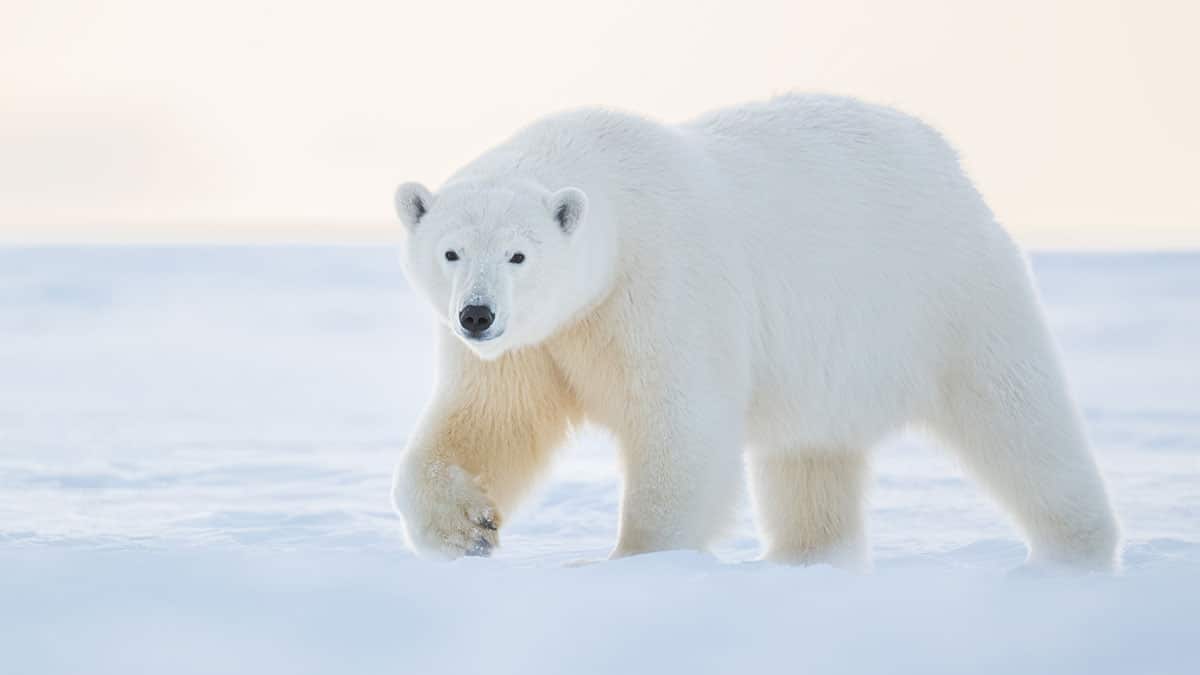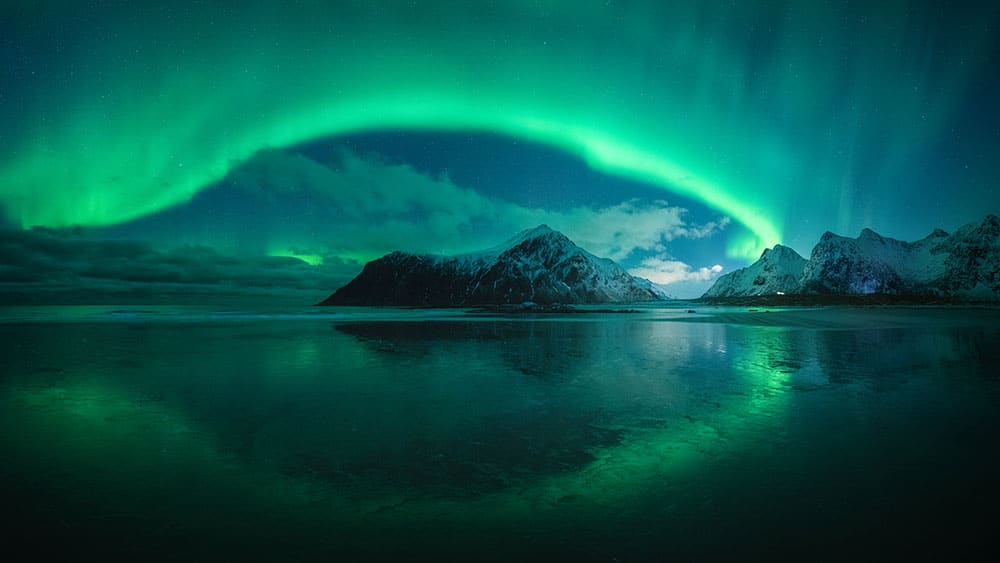
Photo Safari Photography
All you need to know
Photographing animals in the wild is great fun. Most of the time it has to happen pretty fast. Regardless of whether you want to photograph leopards in Africa, tigers in India or ibexes in the Swiss Alps, you usually have very little time to choose the right camera settings or the ideal composition. Our 6 tips will help you to take great wildlife pictures next time.
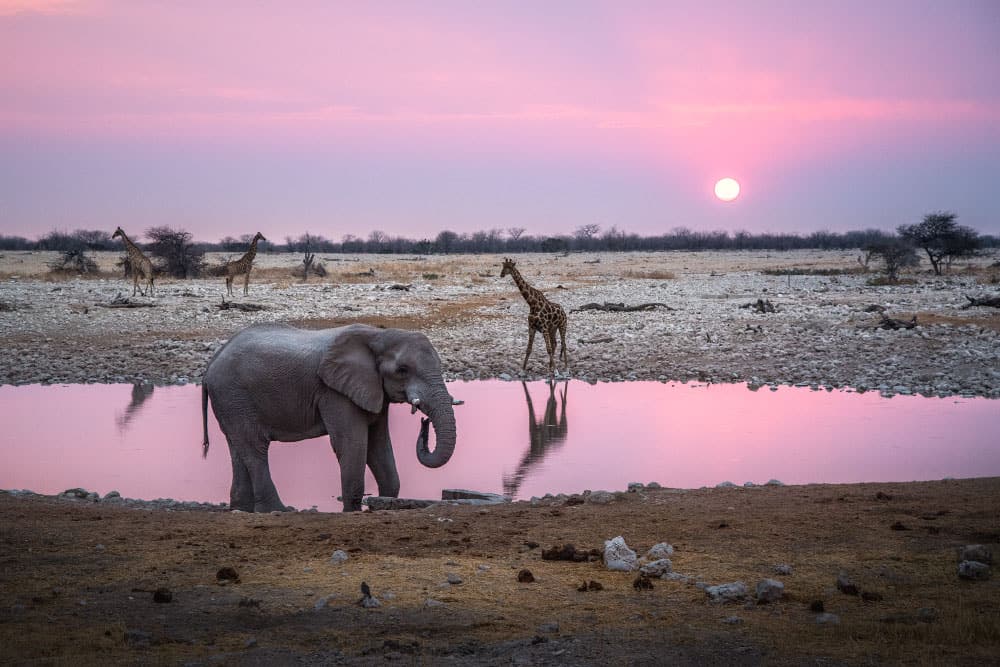
Sunset in Etosha National Park, Namibia
Download free eBook
Join our mailing list now and receive our eBook on wildlife photography with 6 top tips in handy PDF format.
6 Tips for your next Photo Safari
1. Know your equipment
On a photo safari, things often happen very quick, a spectacular wildlife sighting often takes place within a few seconds. It is therefore particularly important that you know your camera equipment inside out and that you can react quickly.
You should know about these points and be able to react quickly to make the necessary adjustments:
- What is the minimum shutter speed you can use with your camera and subject combination to create sharp images?
- Where do I set the exposure time, aperture and ISO?
- Where do I quickly switch between focus modes or focus points?
- Where can I quickly switch between multi-field / spot metering?
- How high can I go with the ISO on my camera without big losses or too much noise in the image?
2. Use the ideal camera settings
If you’re new to wildlife photography, it’s worth visiting a nearby zoo or animal park to familiarize yourself with your equipment and the animal subjects. Try out the most important settings on your camera. A certain routine will help you when things get “serious”.
Use the aperture priority (A / Av)
This allows you to manually select the desired aperture and the camera then calculates the required shutter speed. Depending on the aperture, you can creatively design your shot. To make the animal stand out from the background and create a nice bokeh effect, choose an open aperture, e.g. f/4.

In this shot, we deliberately opened the aperture so that the background would be nicely blurred and thus the deer would come into better focus.
Nikon D500, 300 mm f/2.8, 1/640s, f/6.3, ISO 400
Choose the ideal ISO value to achieve a fast enough shutter speed
Set the ISO value manually. Always pay attention to the shutter speed the camera gives you at the selected aperture. If your shutter speed is too slow, increase the ISO value. Especially with telephoto lenses, it is important to choose a fast enough shutter speed. Otherwise, you run the risk of blurring your shots. When using telephoto lenses, you should use a shutter speed of at least 1/600s or even better 1/1000s and higher, depending on the lens, the movement of the animals and the lighting conditions.
As an alternative to manual ISO selection, you can also use the ISO automatic, i.e. the camera itself selects the appropriate ISO value. However, it is important that you limit the highest ISO value, i.e. you set the camera so that the ISO value may not be higher than ISO 2000, for example. This is the only way to ensure that the images will not be (too) noisy.
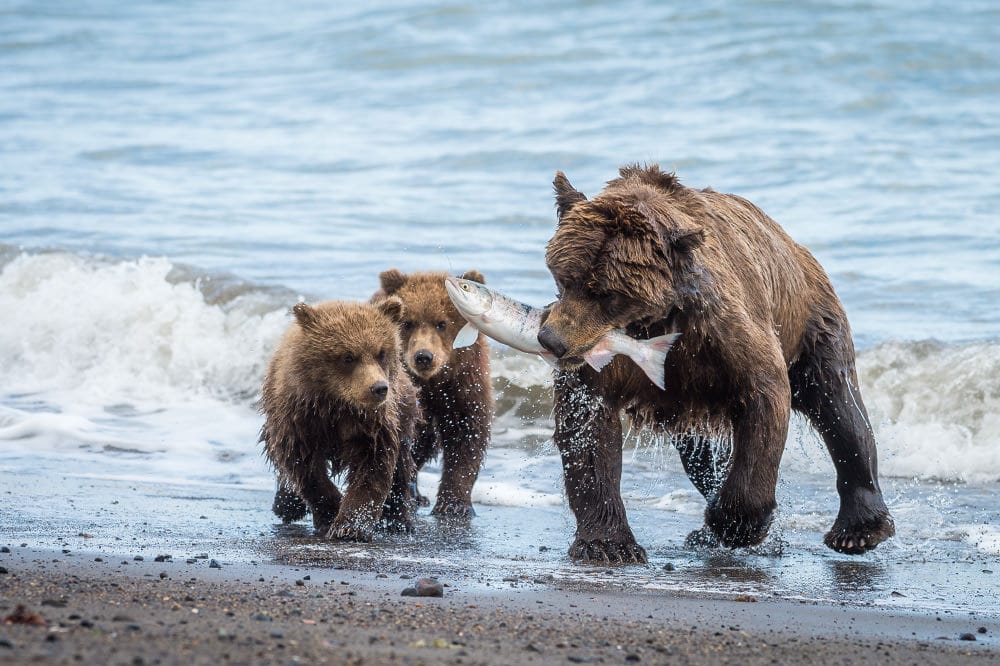
This mother bear marched relaxed back to land after the successful fish hunt. To keep the bears sharp despite the movement, we increased the shutter speed a bit here.
Nikon D4, 300mm f/2.8, 1/800s, f/8.0, ISO 400
3. Know your subject
Wildlife photography is all about capturing interesting animal behaviour. For example, there is nothing more boring than sleeping lions. On safari, you want to capture animals in motion or interacting with each other. This results in exciting shots that immediately catch the eye of the viewer. To get to know the behaviour of the individual animals you should invest a lot of time in their observation. Don’t chase from one animal to the next, spend rather a little time with one animal and observe it. This way you can learn a lot. On a safari, the trained guides will also help you. Ask them lots of questions about the animals. This way you learn a lot about nature and the animals. This helps you immensely in photography and you can weigh up how the animal will behave and prepare yourself accordingly for the situation.

Bee-eaters often hunt near their burrow. They hunt for insects, fly to their burrow nearby to feed the young and then fly back to their starting point. Usually they use the same branch over and over again to do this. An ideal conditions to lie down and wait with the camera.
Nikon D500, 180 – 400mm f/4, 1/200s, f/6.3, ISO 2500
4. Observe the most important rules of image composition
If you place the main subject of your shot incorrectly, the photo will lose tension. When taking photos, pay attention to a few basic rules in image composition:
Rule of thirds
The image is divided into thirds vertically and horizontally. Striking or important image content, such as the animal’s eye or the animal itself, should ideally be positioned in one of the intersections.

Example of third rule in wildlife photography
Nikon D4, 300 mm f/2.8, 1/2000s, f/6.3, ISO 800
Pay attention to backround
The background also often determines whether a photo looks good or not. As a rule, it is important that nothing disturbing or dominant interferes with the photo subject. Look carefully through the viewfinder and watch for other safari vehicles, other animals that interfere with the silhouette of the photo subject, highly reflective leaves, or that the horizon line does not break the silhouette of the animal. It is important that the background is as simple as possible and does not unnecessarily distract from the main subject.

Elephants in the background disturb the silhouette of the main subject
Nikon D850, 24-85mm f/3.5-4.5, 1/2000s, f/8, ISO 640
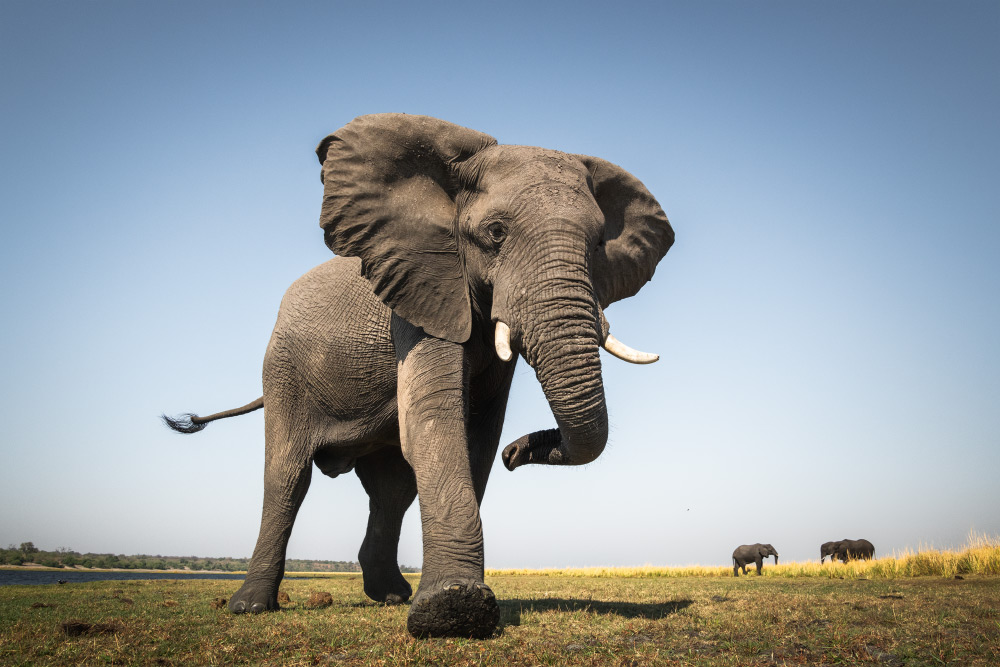
The same subject, without disturbing elements behind the elephant
Nikon D850, 24-85mm f/3.5-4.5, 1/2000s, f/8, ISO 640
Include the surroundings
Many photographers try to fill the image completely with the subject. However, it can be just as interesting to show your photo subject in its natural environment or to include it in the image composition.

Typical forest scene in Mana Pools National Park.
Nikon D810, 70 – 200 mm f/2.8, 1/500s, f/8, ISO 800
Focus on the eyes
This is one of the basic rules in wildlife photography. If the eyes are not in focus, few viewers will feel engaged by the image. Of course, if there is eye contact with the animal, this helps to connect the viewer with the animal. But this is not always necessary. There are many beautiful shots where the animal is looking into the distance or at another animal in the picture. If the animal is not looking at the camera, you should make sure that it is looking toward the center of the frame and not the other way around. Also, the animal’s eyes should be clearly visible and not in shadow.

To show off the dark eyes of this reindeer, we deliberately overexposed this shot. The overexposure also makes the snow look nice and white. It’s also important with a shot like this that the focus is right on the eyes so that they are nice and sharp.
Nikon D4, 200 – 500 mm f/5.6, 1/1250s, f/7.1, ISO 800, + 1.3 EV
5. Be patient
Patience is the most important requirement for a great animal shot. The more time you spend with an animal, the greater the chance that something unexpected or exciting will happen. However, a lot of time can pass before something exciting happens. Wildlife photography also requires a large portion of luck. You have to be in the right place at the right time. It is inevitable that you bring a lot of patience.
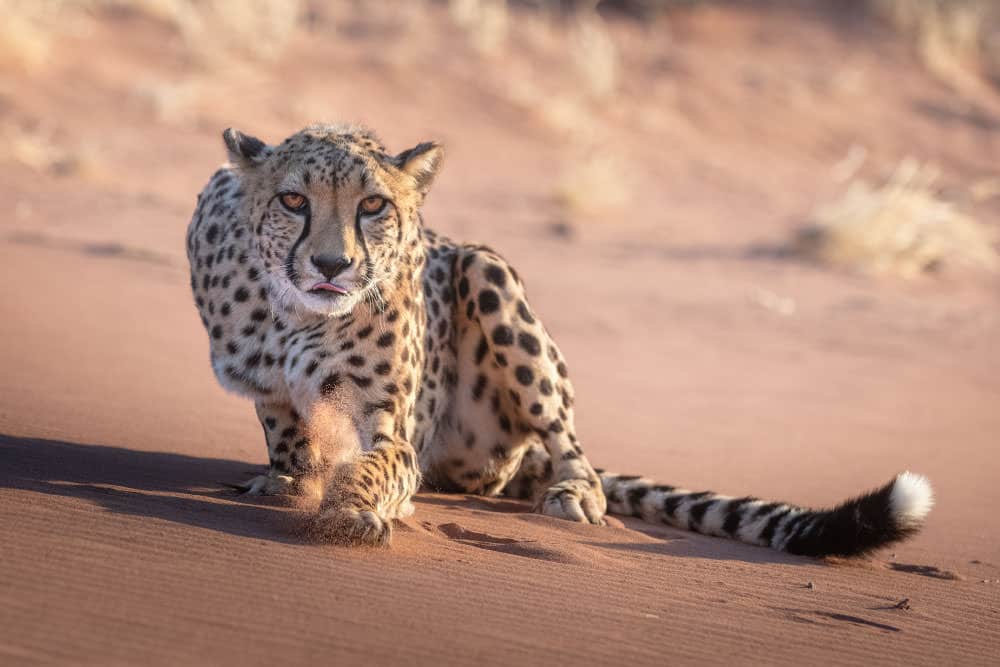
Big cats in Africa sleep many hours a day. It is worth to be a little more patient and wait a little longer. As soon as they get up beautiful “action” pictures can be taken.
Nikon D850, 70 – 200 mm f/4, 1/2000s, f/4, ISO 800
6. Be creativ
The classic in animal photography are portraits. The supreme discipline, however, is to document the animal in its natural habitat, e.g. integrating an animal into a landscape shot or focusing on special details. The pattern of the animal’s fur, eyes, paws or other detail shots can result in exciting motifs. Just try out what you like. Besides all the rules in photography, the rule “break the rules” also counts. Be creative!

Normally, one would overexpose in such a situation to get a good view of the leopard. But because the sky in the background was shining in beautiful colours, we deliberately underexposed here to get a nice silhouette of the leopard.
Nikon D750, 70-200mm f/2.8, 1/1250s, f/2.8, ISO 1000, -0.3 EV
Download free eBook
Join our mailing list now and receive our eBook on wildlife photography with 6 top tips in handy PDF format.
